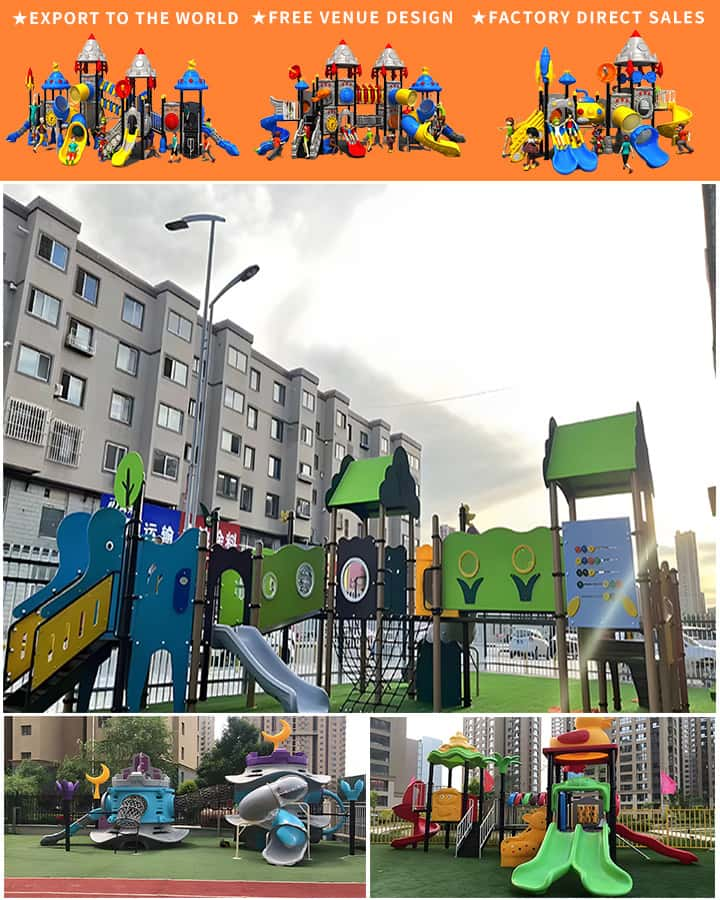Kids’ playgrounds are vibrant havens filled with laughter, joy, and endless opportunities for fun. The colorful array of playground equipment captivates young minds and bodies, offering them a place to explore, play, and develop essential skills. Let’s take a closer look at some common types of playground equipment, their names, and descriptions, accompanied by imaginative illustrations to make this guide vivid and engaging.
1. Swing Set
A staple in nearly every playground, the swing set is beloved by children everywhere. Swings come in various shapes and designs, from traditional single-person swings to modern multi-person models. Children love the sensation of flying through the air and the challenge of reaching higher and higher. [Image: Colorful swing set with two kids enjoying the swings]
2. Slide
Slides are synonymous with childhood joy. Whether it’s a simple metal slide or a complex spiral model made of plastic, slides provide a thrilling ride that kids adore. Sliding down offers an exhilarating rush, and climbing up to slide again ensures continuous play. [Image: Bright red slide with cheerful children waiting in line]
3. Monkey Bars
Monkey bars, also known as horizontal ladders, are perfect for building upper body strength and coordination. Children grasp, swing, and maneuver across the bars, which helps in developing both motor skills and confidence. [Image: Kids hanging and playing on monkey bars under blue sky]
4. Merry-Go-Round

The merry-go-round brings a sense of whimsy and excitement to any playground. Powered either manually or mechanically, these rotating structures offer a gentle spinning motion that delights children and can be enjoyed solo or with friends. [Image: Merry-go-round adorned with colorful seats and spinning happily]
5. Seesaw
A classic seesaw provides interactive fun, encouraging cooperation and balance between its users. It’s great for teaching kids about equilibrium and sharing as they work together to make it go up and down. [Image: Two kids playing on a seesaw, one up high while the other goes down]
6. Climbing Wall
Climbing walls challenge kids to use their muscles and problem-solving abilities to reach the top. These vertical structures come in different heights and textures, providing varying levels of difficulty. [Image: A group of adventurous kids climbing up a textured wall]
7. Sandbox
Sandboxes are excellent for fostering creativity and fine motor skills. Children can dig, build sandcastles, and create intricate designs using toys like shovels, buckets, and molds. [Image: Sandbox filled with golden sand, surrounded by kids engrossed in play]
8. Spring Rider
Spring riders offer a bouncing experience that mimics horse riding. As kids sit on the springy base and bounce up and down, it enhances their leg strength and balance in a playful manner. [Image: Kids laughing on spring rider, enjoying the up-and-down motion]
9. Playhouse
Playhouses are miniature replicas of real houses where children can engage in pretend play. They often come equipped with features like windows, doors, and sometimes even slides, making them a hub for imaginative adventures. [Image: Cute playhouse with a child peeking out from the doorway]
10. Balance Beam
Balance beams are narrow platforms elevated off the ground, designed to help kids improve their balance and coordination as they walk across. These structures can be simple wooden beams or part of more complex playground setups. [Image: Balance beam with handrails, a child carefully walking along it]
Conclusion
From swing sets to slides, each piece of playground equipment contributes uniquely to a child’s physical development, social skills, and overall happiness. By understanding the names and features of these playground favorites, parents and caregivers can better appreciate the diverse opportunities for growth and fun that these spaces provide. Whether it’s through soaring on swings or conquering climbing walls, children find endless joy and adventure in these well-loved play areas.




